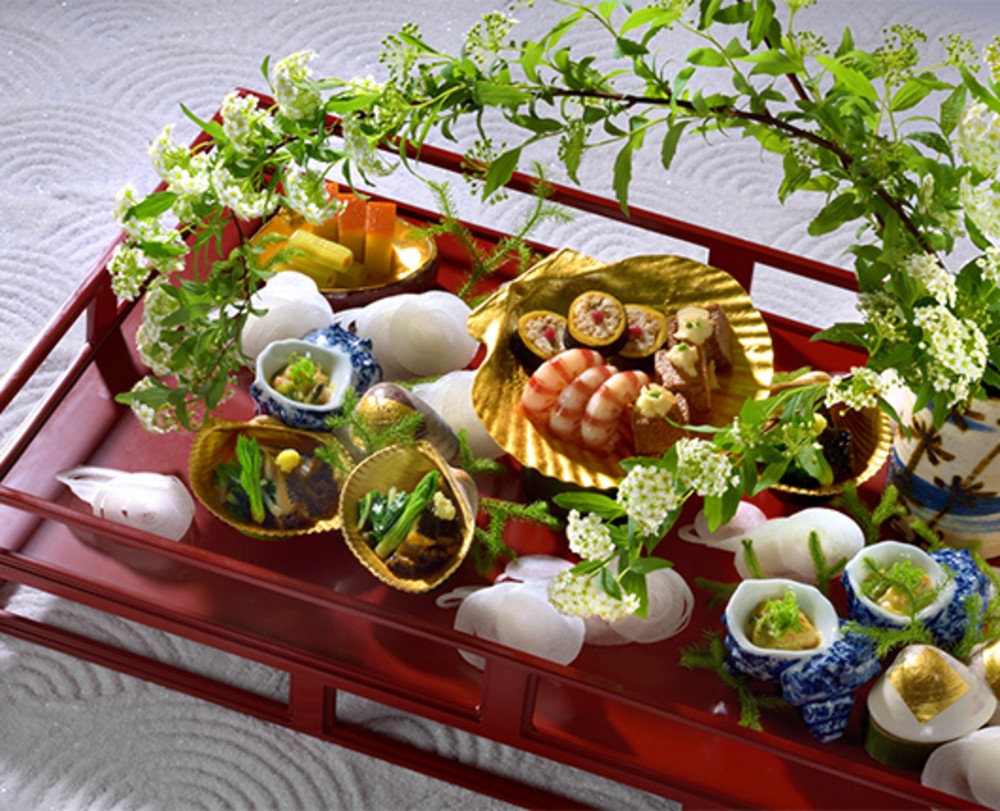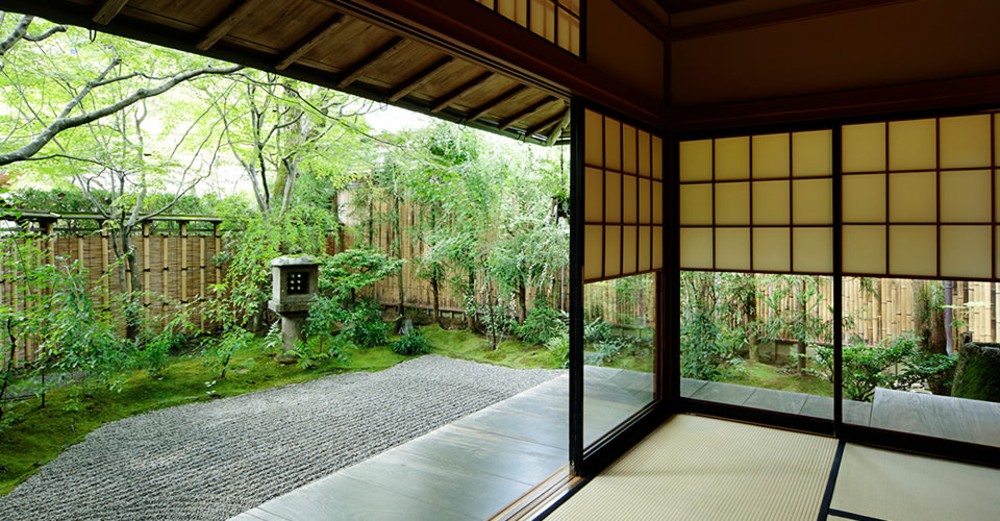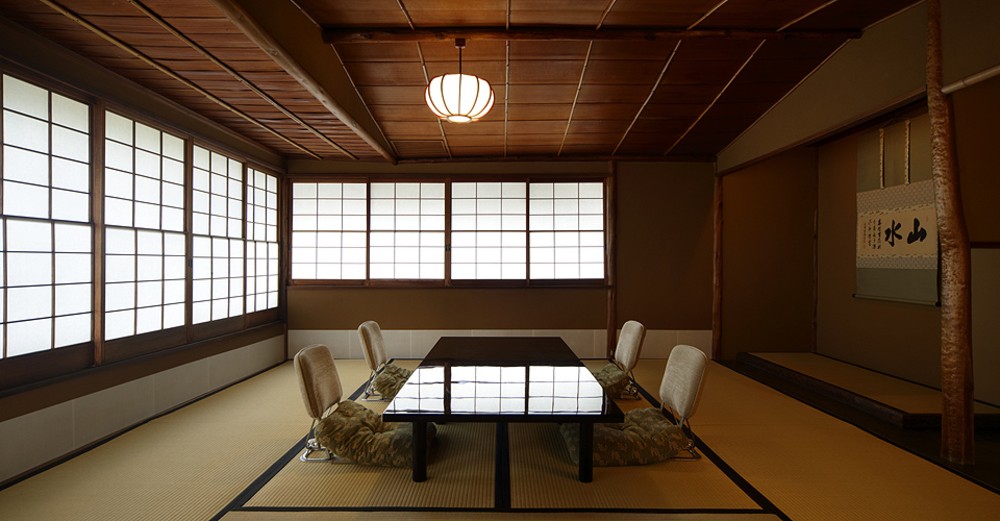
Presented on a Hassan wooden box, an assortment of gold-painted seashells act as vessels bearing seasonal delicacies plucked from around Japan. The crowning shell is presented on a floral and cobalt blue ceramic and holds the Kuruma Ebi which comes with wild greens, curling peeled radishes and fresh abalone. More of a cultural immersion; a part art exhibition and part sensory banquet, this is just one flavour of the Kaiseki course promised at the three-star Michelin Kyoto Kitcho Arashiyama. A restaurant based on Japanese tea ceremony traditions, guests dine in a classic Ryokan setting, overlooking a serene and meditative garden while devouring traditional Japanese cuisine.

Giving equal importance to visual design and flavours, this award-winning and family-run restaurant seeks to transmit Japanese heritage through “umami”, translated as savouriness and “omotenashi”, meaning wholehearted hospitality. Believing Kaiseki to be the embodiment of “omotenashi”, the tea ceremony inspired experience at Kyoto Kitcho Arashiyama is founded on respect; making guests feel unique and at ease. While its second central mission is to produce meals that are expressions of seasons and place.
It all began in 1925 when founder, Yuki Teiichi, discovered Chakaiki – tea gathering records that detailed a compendium of Kaiseki menus. It was the seasonal nature of this cuisine that fascinated Yuki, and after having made an exhaustive study of them, he brought kaiseki into the Japanese haute culture when he opened the restaurant in 1948. Each generation since has ensured the restaurant retains its traditions, and Yuki’s grandson and current owner, Tokyoka Kunio, continues this mission by devoting himself to studying traditional cooking techniques.

As one draws up to the restaurant, two grand wooden pillars command solid fences to conceal the property from onlookers. But the peeping scarlet and parakeet green foliage hint at the oasis behind, and those few who give their reservation name to the gatekeeper are granted access through. Proceeding onwards, diners come to another traditional Japanese bamboo gate. Since this entrance is short and narrow, guests must bow to get inside – an intentional act Tokyoka Kunio says – as its design enforces people and their feelings to be closer and respectful to one another. “Omotenashi” has begun, and the sacredness of “umami” is afoot.

Guests are escorted to private classic tatami rooms, indicative of conventional tea ceremony houses. The tawny colour of the fusuma (sliding doors) are gentle on the eye, while the mats, low tables and cushioned seats are uber comfortable, immersing diner’s in an ancient Japanese dining practise. Additionally, at the heart of Kaiseki dining is the principle of “shun” – the taking of ingredients at the peak of their freshness. Since each course is adorned with flavours and floral arrangements reminiscent of the present season, the private rooms’ open doors leading to the garden pay homage to this customary principle.

Ingredients are carefully selected; Tokyoka Kunio, who is also the chef, conjures dishes that allow each seasonal ingredient to shine, and flavours to savour. His intent is to emphasise a seamless synergy between cuisine and natural beauty and cuisine and artistic expression.
There are a number of different courses to a Kaiseki meal, but a theatrical display of colour, texture, spices, fruits and meats will undoubtedly delight the senses. Vibrant autumn leaves embellish the autumnal menu, and tender cherry blossoms enliven the spring presentation of sushi dishes, where the food comes arranged like an under-the-sea diorama or in the formation of flowers. Expect also pieces of lobster organised into bunches of threes and gathered with spiced leaf vegetables and slight sticks of fried kelp to create the suggestion of a bough.

The experience, however, goes beyond the physical delight as servers sit nearby to educate on the properties and traditions behind the ingredients. Consequently, the tasting of wasabi and seaweed encrusted with gold foil and drizzled with soy and plum sauce becomes a moment that’s exceptional, creating a lasting memory. One gains a deeper appreciation and understanding for the lotus roots, sweet yams, okra and pumpkin omelettes wrapped in a lotus leaf, as they realise it has been prepared with Japan’s multi-layers of heritage.

For a night of wonder, the Chefs “Omakase” course, meaning “I’ll leave it up to you” has the chef conjuring bespoke menus. Preparing the meal in your private room, hints of dishes like briny blue crab adjoined with sour vinegar jelly, or the mildly sweet undertones of the barracuda sushi travel through the air. As one takes in such aromas, guests are encouraged to relax by savouring the fruity flavours of the Kitcho Teio Sake, before ending the evening ends with a refreshing fruit platter accompanied with a restorative melon cream sauce.
Paying homage to Japan’s tea ceremony traditions, Kyoto Kitcho Arashiyama is the pièce de résistance of Kaiseki-dining restaurants. Taking guests on a journey of discovery through “umami” and “omotenashi”, they become acquainted with “shun”- the very best of Japan’s natural ingredients and ancient practises.